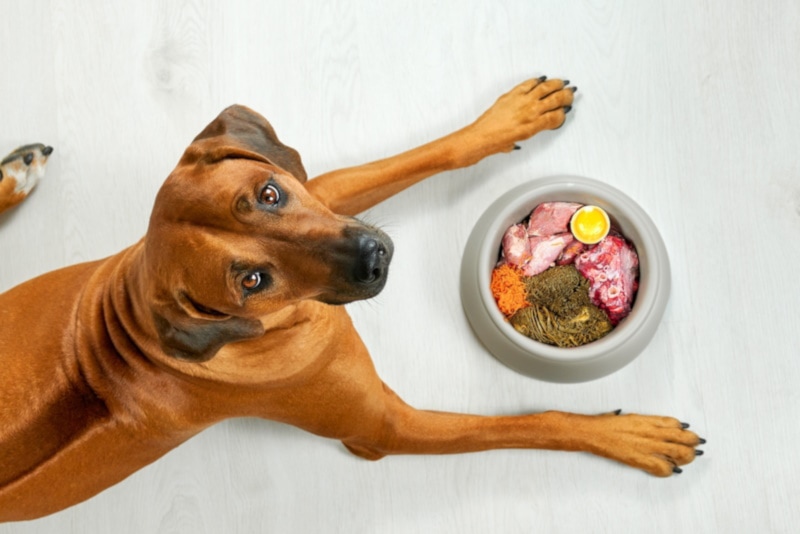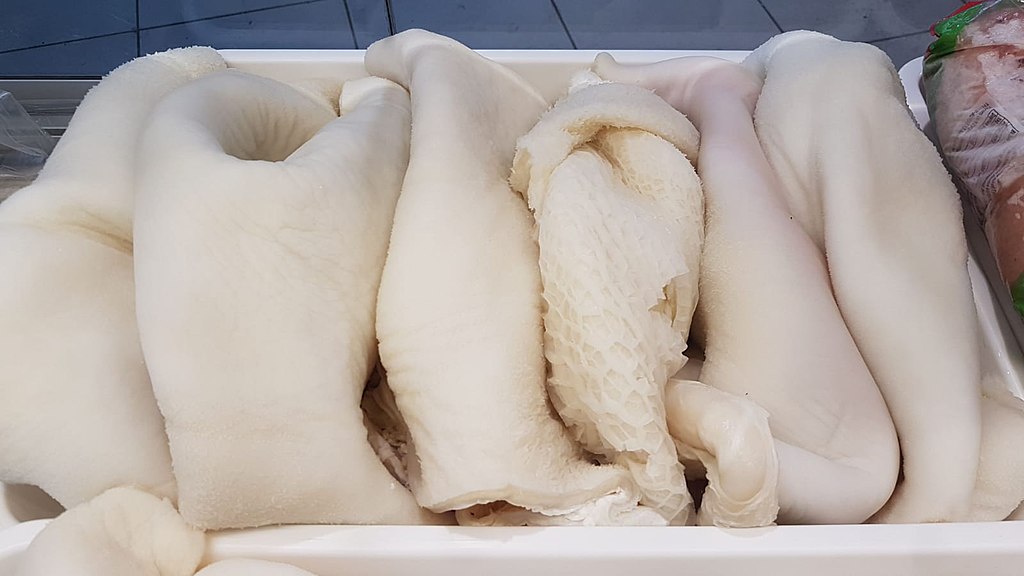Tripe is the lining of a ruminant’s stomach, which includes cows and sheep. It is safe for human consumption, although it is considered an acquired taste with many people balking at the idea of eating it. Tripe, in the appropriate form, is considered safe for dogs to eat and is nutritious while being low in calories. Some people consider it a superfood that can make a very beneficial daily addition to a dog’s food.
Tripe meant for human consumption has been thoroughly cleaned and bleached, giving it a white appearance. However, this removes most of the nutrients that benefit dogs. Therefore, it is advised that dogs be given the unprepared green tripe, instead. One of the only real downsides to feeding tripe to dogs is its smell, which some owners can’t stand.

What Is Tripe?
Tripe is the stomach lining of a ruminant. Although it can come from virtually any type of ruminant, including lambs and even deer, the most readily available tripe is beef tripe. Like all ruminants, cows have four stomachs, and tripe comes from each of the stomachs. It can be bought fresh, frozen, or dried.
It is tough and chewy, and while a tough and chewy stomach lining might not sound appealing to all owners, it tends to be very palatable for most dogs.
Can Dogs Eat Tripe?
Firstly, tripe is considered safe for canine consumption. It might be different compared to what a dog normally eats, which means feeding too much of it in a single sitting can lead to an upset stomach and maybe even vomiting.
Whatever form you buy tripe in, it is safe for your dog to eat, even if it is white tripe. However, it is the green tripe that is most commonly fed to dogs.


The Benefits of Tripe for Dogs
As well as being generally safe for dogs to eat, tripe is also considered very beneficial by some. Some of the health benefits it is claimed it offers include:
- Nearly Ideal Calcium/Phosphorus Ratio – Generally, it is recommended that adult dogs be given food with a calcium/phosphorus ratio of 1.4:1 but tripe’s almost 1:1 ratio is considered close to this. There is a complex relationship between calcium and phosphorus needed to maintain healthy bones. Therefore, ensuring that you provide phosphorus as well as calcium is important and the two are important individually, too. Calcium not only helps bones develop but it also aids in muscle and nerve health. Phosphorus is good for bones, too, while also being beneficial for major organs including the kidneys and the heart.
- Probiotics – Probiotics are friendly bacteria that fight bad bacteria. They improve food digestion and assist in the absorption of vitamins and minerals from food. Tripe not only contains probiotics, but prebiotics too, and these provide food for good bacteria to strengthen them and prolong their life. Probiotics can be especially beneficial for dogs that are on or have recently been on medication like antibiotics.
- Digestive Enzymes – Digestive enzymes work in the gut to help break down food. As the food is broken down, your dog’s digestive system can take on more of the vitamins, minerals, and essential ingredients to meet its daily nutritional requirements.
- Omega Fatty Acids – Omega fatty acids are healthy fats. They make up an important part of your dog’s diet and consist of omega-3, omega-6, and omega-9 fatty acids. Tripe contains a good balance of omega-3 and omega-6 fatty acids. Specifically, these help the body absorb fat-soluble vitamins and they improve heart and brain health. They can also help with good coat and skin health.
- Low Calories – Tripe has fewer calories by weight than most meats, which means that your dog can enjoy the food without putting on too much weight. Being overweight is as dangerous for dogs as it is for people and is strongly linked to heart problems and certain conditions like diabetes. Tripe can help fill your dog up without piling on the pounds.
- Amino Acids – Amino acids combine to form proteins. They are often described as the building blocks of life, and tripe is a complete protein source as it contains all amino acids. Leucine assists in muscle repair, which is great for active dogs; proline aids in healing wounds; and aspartic acid encourages antibody production, which fights disease and infection.
- Good for Food Allergies – Tripe is a good food for dogs with sensitivities because it is less likely to trigger them. Similarly, despite coming from cows or lambs, which are considered red meat, tripe contains low levels of myoglobin and is, therefore, considered white meat instead.
Green Tripe vs White Tripe
If you’ve ever eaten or seen tripe in a store, you most likely saw tripe that has been prepared for human consumption. It is washed and then bleached, which gives it a white appearance. However, washing and bleaching remove many of the ingredients considered beneficial. Green tripe, or raw tripe, has not been washed or bleached and it retains more of the pre and probiotics and digestive enzymes.
While white tripe is perfectly safe for dogs to eat, and you can certainly let your pup have some if you’re preparing tripe for your own meal, if you are buying tripe specifically to give to your dog, you should opt for green tripe.

How to Feed It
You can buy fresh, frozen, or dried tripe. You can also get it in cans. Canned can be a good way of keeping tripe without it stinking out the fridge because tripe in any form has a very strong and unpleasant aroma. Fresh tripe will most likely be found at a butcher’s or farm shop, and frozen can be found in some stores.
Raw tripe can simply be broken up and fed to your dog. Start with a small amount and try sprinkling it on top of your dog’s food. Feeding too much too soon may cause diarrhea and an upset stomach so you will want to start gradually. Raw enthusiasts recommend that green tripe is best served raw. Many other people recommend cooking it as raw meat and especially tripe has been shown to be contaminated with bacteria.

Conclusion
Tripe divides opinions between people. Some enjoy its rubbery texture and unique smell, while others loathe the very idea of eating a cow’s stomach lining. However, tripe is considered a good food for dogs. Green tripe, which is raw and unprocessed, is packed full of vitamins and minerals, as well as a host of amino acids, probiotics, and digestive enzymes while being lower in calories than meat alternatives.
Opinion is divided as to whether you should cook it first or feed it raw. This will come down to your own preferences but hygiene precautions must be taken if feeding raw tripe. It can be a little rich for dogs when they first try it, however, so you will need to start with small amounts and build up to feeding more.
- See also: Can Dogs Eat Pigs’ Feet?
Featured Image Credit: Alp Aksoy, Shutterstock










